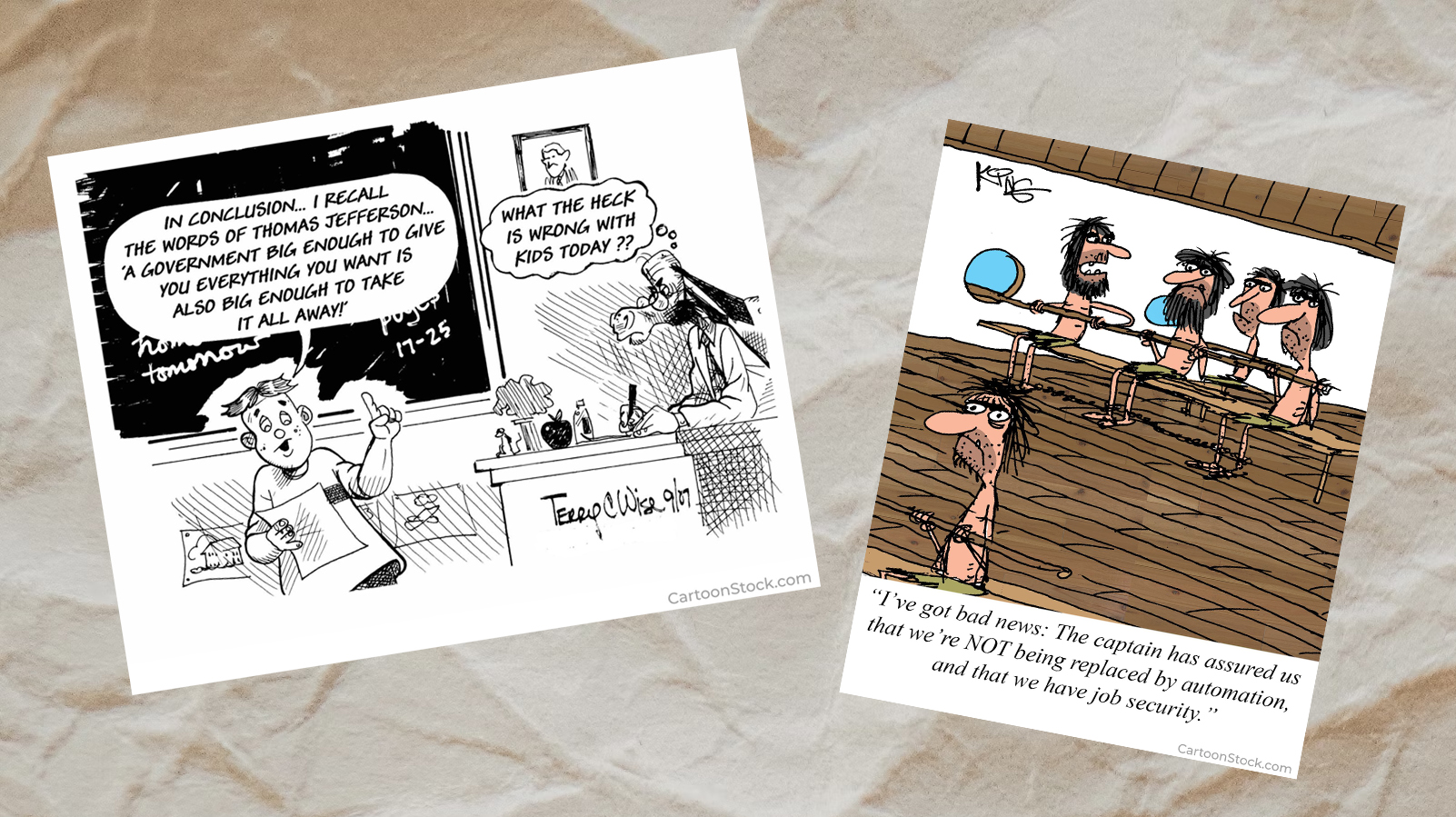Political cartoons have been a staple of public discourse for centuries, offering quick, visual, and often satirical commentary on current events. For students, they present a unique opportunity to engage with important issues in a way that’s both thought-provoking and fun. But while these cartoons may appear simple, their layered meanings can open the door to deeper discussions about media literacy, bias, free speech, and critical thinking.
At Stossel in the Classroom, we know the power of political cartoons. That’s why many of our Teacher’s Guides include activities centered on analyzing cartoons. Whether your students are exploring the principles of free speech, economic concepts, or public policy debates, cartoons can help them sharpen their analytical skills and connect with the material in a dynamic way.
Why Political Cartoons Matter in Public Discourse
Political cartoons distill complex issues into single, impactful images. By combining humor, exaggeration, and symbolism, they provoke reactions, raise questions, and sometimes challenge assumptions. Over the years, cartoonists have been instrumental in shaping public opinion and spotlighting societal tensions.
For students, these cartoons serve as valuable tools to:
- Encourage Critical Thinking: Cartoons often exaggerate or oversimplify an issue to make a point. Asking students to identify the artist’s message, intended audience, and any potential biases helps them analyze arguments and think critically.
- Understand Historical and Modern Context: Political cartoons provide snapshots of key moments in history or current events. They can make abstract concepts, like economic policies or civil liberties, more relatable and accessible.
- Evaluate Media and Persuasion: Political cartoons are editorial pieces, and like any form of media, they come with perspectives. Teaching students to identify rhetorical techniques—such as irony, symbolism, or caricature—helps them become more discerning consumers of information.
Bringing Political Cartoons into Your Classroom
Using political cartoons with students doesn’t have to be intimidating. You don’t need to be an art critic or political analyst to guide engaging, insightful discussions. Here are a few strategies to try:
- Start with Observation:
Begin by asking students to describe what they see in the cartoon—no interpretations yet. What symbols, characters, or words are used? This helps students focus on the details before jumping to conclusions.
- Move to Interpretation:
Next, ask guiding questions to help students dig deeper:
- What issue is the cartoon addressing?
- What message or opinion is the artist conveying?
- What techniques (e.g., exaggeration, irony, labeling) make the cartoon effective?
Encourage multiple interpretations and remind students that cartoons often provoke strong reactions, which can lead to productive discussions.
- Tie It to the Bigger Picture:
Once students have analyzed the cartoon, connect it to a broader lesson. For example:
- If you’re studying free speech, ask how political cartoons reflect the role of satire in public discourse.
- If you’re teaching economics, use cartoons to highlight debates about government spending, taxation, or incentives.
- If you’re covering a historical period, show cartoons from that era and ask how they reflect the cultural and political climate. How does this differ from our current culture?
- Encourage Creativity:
One of the most engaging ways to help students understand political cartoons is to have them create their own. Ask them to select an issue they care about and design a cartoon that conveys their perspective. This activity fosters creativity while reinforcing their ability to distill complex ideas into a clear message.
Explore Our Cartoon Activities at SITC.org
At Stossel in the Classroom, we’ve incorporated political cartoon worksheets into many of our video-based Teacher’s Guides. These activities give students a structured way to approach cartoons, helping them build media literacy and critical thinking skills. Plus, they provide a great way to integrate visual learning into your lessons.
For example, after watching a video on free speech or economic policy, students might analyze a political cartoon that highlights opposing perspectives. This allows them to see how different viewpoints can be conveyed visually and offers a launching point for deeper discussions or debates.
One of our preferred sites for finding political cartoons is https://www.cartoonstock.com/. It includes a solid search function, so if you’re looking for cartoons to use with a particular topic, it’s a great place to start.
A Fresh Way to Engage Students
Political cartoons are more than just funny drawings—they’re powerful tools for sparking conversations about the issues that shape our world. By encouraging students to analyze cartoons and consider their messages, you’re helping them develop critical thinking, media literacy, and a stronger understanding of public discourse.
So next time you’re looking for a way to engage your students in a lesson, consider adding a political cartoon activity. Whether you’re pulling cartoons from a newspaper, history book, or one of our guides at SITC.org, you’ll find that students are eager to dive in—and they just might surprise you with their insights!



